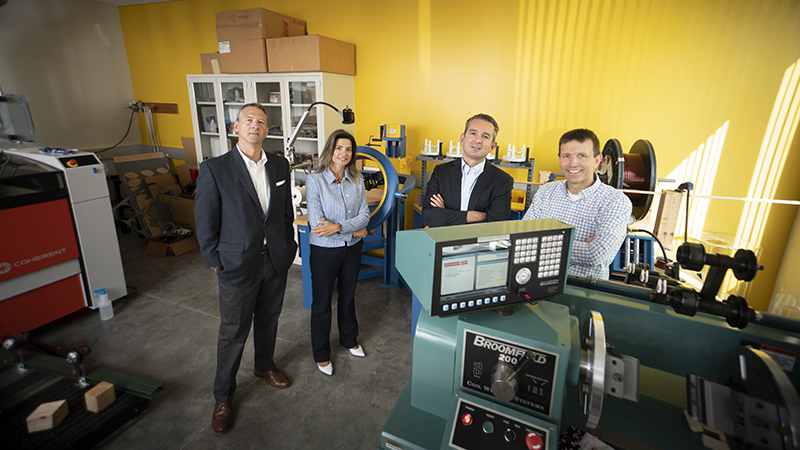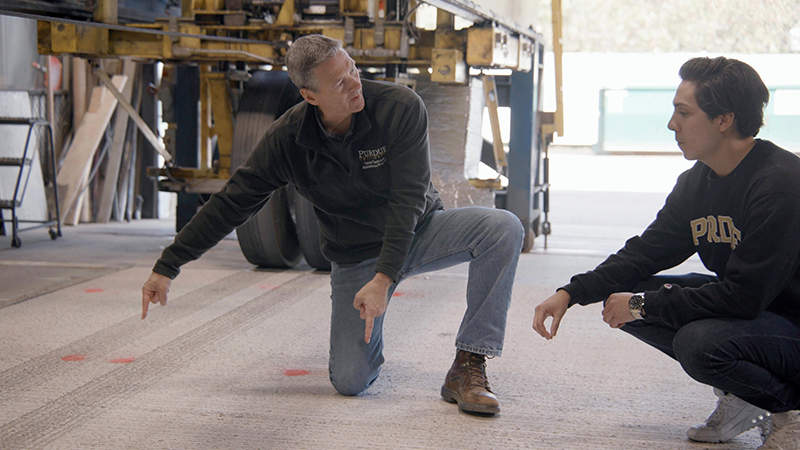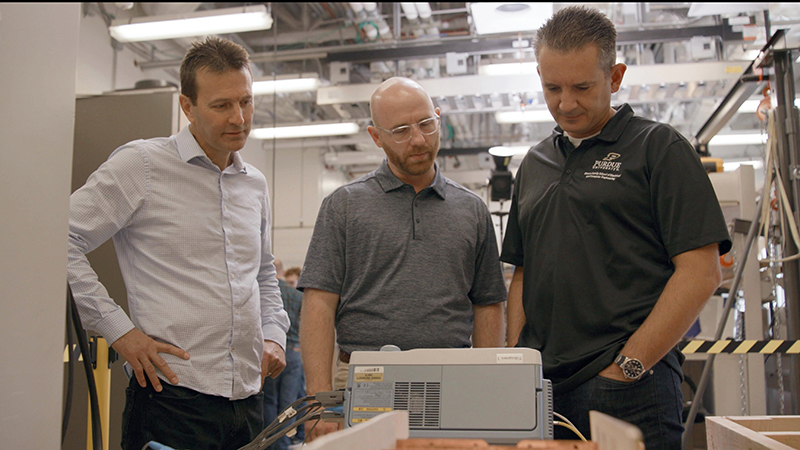May 8, 2023
Building the first highway segment that can charge electric vehicles as they drive

Purdue University engineers, from left, John Haddock, Nadia Gkritza, Dionysios Aliprantis and Steve Pekarek stand in the lab where they are testing technology they designed to enable electric vehicles to receive power from the road. (Purdue University photo/Vincent Walter)
WEST LAFAYETTE, Ind. – If you’ve wanted an electric vehicle but worry how far you could drive between charges, Purdue University engineers and the Indiana Department of Transportation are working on a solution: highways that could wirelessly charge EVs on the go.
An electrified highway in Indiana would serve much of the nation’s traffic. Eighty percent of the U.S. can be reached within a day’s drive from the state’s pass-through highways.
The research team plans to construct a quarter-mile test bed to provide power to heavy-duty trucks on U.S. Highway 231/U.S. Highway 52 in West Lafayette tentatively later this year. In the next four to five years, the hope is to electrify a section of an Indiana interstate.
The results of this study are a step toward figuring out how to transfer high power to longer stretches of pavement at highway speeds and equip EVs to obtain power along them.
“Thanks once again to some engineers and pioneers from Purdue, we’re developing the world’s first highway test bed for wireless charging,” said Indiana Gov. Eric Holcomb in November to attendees of COP27, a United Nations environmental conference that took place in Egypt. “Please remember that one. Yes, we will be testing whether concrete can charge passing trucks – and don’t bet against a Purdue Boilermaker.”
As reported by The New York Times, CNBC, Scripps, Popular Mechanics and other news outlets, the research has the potential to define the future of EV charging.
“The goal is to bring the charge to vehicles, rather than the vehicle stopping at charging stations,” said Nadia Gkritza, a Purdue professor of civil engineering and agricultural and biological engineering, in an episode of “Resources Radio,” a podcast by Washington, D.C., research institution Resources for the Future.
The project is funded by INDOT through the Joint Transportation Research Program at Purdue. The project also is affiliated with a National Science Foundation Engineering Research Center called Advancing Sustainability through Powered Infrastructure for Roadway Electrification (ASPIRE). Utah State University leads ASPIRE in partnership with Purdue, the University of Colorado Boulder, the University of Texas at El Paso and the University of Auckland in New Zealand. Gkritza is the campus director of ASPIRE’s Purdue location.
“We don't envision 100% of the roads being electrified,” Gkritza said, “but we see the potential for dynamic wireless power pavement technology as complementary to an expanding network of EV charging stations that we will see very soon here in the U.S. We feel it would be useful in areas where charging stations are scarce in underserved communities, even supporting transit routes where initial charging at the depots and terminal stations might not be enough and there might need to be some charging in between the routes.”
 Professor John Haddock and graduate student Oscar Moncada examine a slab of concrete pavement they are testing to handle heavy truck loads with wireless power transfer technology installed below the surface. The machine behind them is designed to imitate those loads by repeatedly passing half a loaded semi-truck axle across the concrete slab. (Photo provided by Consensus Digital Media)
Download image
Professor John Haddock and graduate student Oscar Moncada examine a slab of concrete pavement they are testing to handle heavy truck loads with wireless power transfer technology installed below the surface. The machine behind them is designed to imitate those loads by repeatedly passing half a loaded semi-truck axle across the concrete slab. (Photo provided by Consensus Digital Media)
Download image
Electrified roads that charge EVs like a smartphone
ASPIRE’s Purdue location and Cummins Inc., an Indiana-based company specializing in diesel and alternative fuel engines and generators, are also leading a project funded by the U.S. Department of Energy to develop an EV charging and hydrogen fueling plan for medium-duty and heavy-duty trucks on the Midwest’s Interstate 80 corridor. The corridor serves Indiana, Illinois and Ohio. The plan will examine the use of the wireless power transfer technology that Gkritza and her team are testing.
For their project with INDOT, Purdue researchers are focusing first on testing how well the technology transfers power to electric trucks. These trucks are more limited than smaller electric vehicles in how far they can drive because their larger batteries are heavier. If electric trucks could charge using highways, their batteries wouldn’t need to be as big and they could carry more cargo, significantly reducing costs.
“We’re developing a system that has the power to charge semitractor-trailers as they move 65 miles per hour down the road,” John Haddock, a professor in Purdue’s Lyles School of Civil Engineering, told U.S. News & World Report.
The technology would enable the pavement to provide power to EVs similarly to how newer smartphones use magnetic fields to wirelessly charge when placed on a pad.
“If you have a cellphone and you place it on a charger, there is what’s called magnetic fields that are coming up from the charger into that phone. We’re doing something similar. The only thing that’s different is the power levels are higher, and you’re going out across a large distance from the roadway to the vehicle,” said Steve Pekarek, Purdue’s Dr. Edmund O. Schweitzer, III Professor of Electrical and Computer Engineering, in an episode of “American Innovators,” a Made in America series by Consensus Digital Media. “This is a simple solution. There are complicated parts of it, and that we leave to the vehicle manufacturers.”
Embedded into the pavement are transmitter coils that would send power to receiver coils attached to the vehicle’s underside. The Purdue team designed both sets of coils and have disclosed their innovation to the Purdue Research Foundation Office of Technology Commercialization, which has applied for a patent on the intellectual property.
Laying the groundwork for roads that recharge EVs everywhere
In practice, the transmitter coils for wireless power transfer would be installed in specially dedicated lanes underneath normal asphalt or concrete pavement. The team has completed testing of how well 20-foot-long sections of asphalt and concrete could handle heavy loads with the transmitter coils embedded. The researchers imitated truck traffic by having a machine repeatedly drive a loaded one-half semi-axle over the pavements.
Alongside the pavement mechanical tests, the team also has done lab tests verifying the electromagnetic performance of the bare transmitter coils and the receiver coils that would be built into a vehicle’s underside.
“The whole idea is if you can charge your car on the road while in motion, then you’re basically riding for free,” Aaron Brovont, a Purdue research assistant professor in Purdue’s Elmore Family School of Electrical and Computer Engineering, explained in a Scripps news segment.
 In a Purdue electrical engineering lab, Steve Pekarek, from left, Aaron Brovont and Dionysios Aliprantis measure the electromagnetic performance of coils they are developing to transmit power to receiver coils on electric vehicles as they drive. (Photo provided by Consensus Digital Media)
Download image
In a Purdue electrical engineering lab, Steve Pekarek, from left, Aaron Brovont and Dionysios Aliprantis measure the electromagnetic performance of coils they are developing to transmit power to receiver coils on electric vehicles as they drive. (Photo provided by Consensus Digital Media)
Download image
The researchers anticipate that it may be 20 to 30 years before EVs can receive the full power they need while driving at highway speeds. It would be up to EV manufacturers to decide whether to incorporate receiver coils into their vehicles.
“The technical obstacles that we need to overcome are not insurmountable. Those can be overcome with proper design,” Dionysios Aliprantis, a Purdue electrical and computer engineering professor, told The New York Times.
The team hopes the results of their experiments would help convince the industry that electrified highways could work.
“We are Purdue University, where the difficult is done today and the impossible takes a bit longer,” Haddock said.
About Purdue University
Purdue University is a top public research institution developing practical solutions to today’s toughest challenges. Ranked in each of the last five years as one of the 10 Most Innovative universities in the United States by U.S. News & World Report, Purdue delivers world-changing research and out-of-this-world discovery. Committed to hands-on and online, real-world learning, Purdue offers a transformative education to all. Committed to affordability and accessibility, Purdue has frozen tuition and most fees at 2012-13 levels, enabling more students than ever to graduate debt-free. See how Purdue never stops in the persistent pursuit of the next giant leap at https://stories.purdue.edu.
Writer/Media contact: Kayla Wiles, 765-494-2432, wiles5@purdue.edu
Note to journalists: Photos and video of the researchers and their experiments, in addition to b-roll of Purdue University’s campus, are available via Google Drive.

